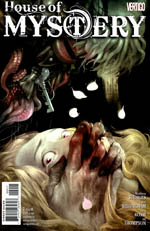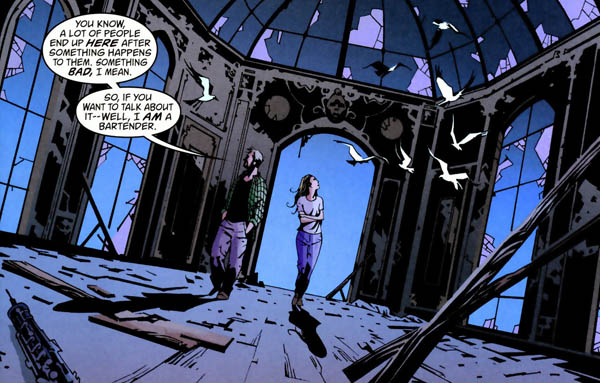 Written by Matthew Sturges and Bill Willingham
Written by Matthew Sturges and Bill Willingham
Art by Luca Rossi, with Sophie Campbell and Jill Thompson
32 pages, color
Published by Vertigo/DC Comics
The new revival of House of Mystery sounded so strange that I simply had to take a look at it: part running narrative about a house that pulls people in and out of its grasp, part anthology thriller with guest artists illustrating short stories. It was, to be honest, a really different hook for a series. Now that I’ve read the first two issues, though, I have to give Vertigo credit for grabbing this pitch; in a market where single issue sales are falling by the wayside, this is a book where I want to buy every issue.
Fig Keele has had better days. Her house just collapsed thanks to two mysterious strangers appearing in her home, chasing her down saying they’re there to “help”. In her escape she plunged into a bizarre mansion called the House of Mystery, where the patrons tell stories for their food and the staff are unable to ever leave. And oddest of all, she’s been dreaming of the House of Mystery for years.
I’m largely unfamiliar of Matthew Sturges’s solo writing work; while he’s had a few credits on his own that I hadn’t read, my main exposure of his craft was co-writing Jack of Fables with Bill Willingham. So when weighing the possibilities of a mostly-unknown (Sturges) versus a tried creator (Willingham), I must admit that I’d assumed that Sturges’s writing would be the less interesting of the two in House of Mystery. Boy, am I red-faced and needing to apologize now. Sturges (who writes the main, continuing storyline in House of Mystery) does a really good job plunging the reader into the book; keeping the tensions high and interesting from the very first page as we follow Fig’s terrified escape across Austin, Texas. Even more impressively, he’s able to keep the book moving at an equally strong level through its second issue. We’re still largely in the set-up portion of the title, but it’s to Sturges’s credit that even if to a reader some of the plot turns are obvious (while Fig’s joining of the staff is a surprise to the characters of the book, I think it’s safe to say that it’s not even meant to be one for us), he still is able to make it exciting to watch happen.

That’s not to say that Sturges relies entirely on shock and surprise and high-adrenaline to keep House of Mystery going, though. It’s some of the smaller touches that really stood out for me. When Fig and Harry are walking through the House, we get the narration comment, “There was always more House. It tangled around itself like an old length of string.” It’s a nice simile, one that is both descriptive and evocative in a way that helps accentuate the art, an extra image to be added to our perception of the House.
 The one hiccup in the book for me was, surprisingly, Willingham’s 5-page short stories. I think I like the concept more than the reality; hearing these side-steps makes me feel a little frustrated that we’ve had to look away from the rest of the storyline for even an instant, that we’re wasting time when we could find out more about Fig and the House and the rest of the staff. And to be fair, the side-story in House of Mystery #1 is very good, a creepy story about motherhood that makes you wonder for a bit if we’re being told a story about motherhood through twisted metaphors, or a horrifying reality. (Sophie Campbell’s art was a great choice for the story as well, actually giving me the shivers in places.) The side-story in House of Mystery #2, on the other hand, doesn’t seem to really go anywhere; it doesn’t stand well on its own or as part of the greater issue, and even with the beautiful Jill Thompson art it made me feel like it just didn’t come together at all, even with the punch line back in the House itself.
The one hiccup in the book for me was, surprisingly, Willingham’s 5-page short stories. I think I like the concept more than the reality; hearing these side-steps makes me feel a little frustrated that we’ve had to look away from the rest of the storyline for even an instant, that we’re wasting time when we could find out more about Fig and the House and the rest of the staff. And to be fair, the side-story in House of Mystery #1 is very good, a creepy story about motherhood that makes you wonder for a bit if we’re being told a story about motherhood through twisted metaphors, or a horrifying reality. (Sophie Campbell’s art was a great choice for the story as well, actually giving me the shivers in places.) The side-story in House of Mystery #2, on the other hand, doesn’t seem to really go anywhere; it doesn’t stand well on its own or as part of the greater issue, and even with the beautiful Jill Thompson art it made me feel like it just didn’t come together at all, even with the punch line back in the House itself.
I’d never heard of Luca Rossi before now, but he’s a great find. His use of blacks in his inking helps give his characters a textured, angular look that is really attractive; it’s like a strange amalgamation of Tony Harris and Peter Snejbjerg, but with still something very different thrown into the mix that makes it uniquely Rossi’s art. And while Rossi does a really good job with drawing all the different characters, I especially love at how much attention he’s given to the look of the House of Mystery itself. Each room is meticulously drawn, from odd-colored individual bricks in the kitchen wall, to the shards of glass and flying seagulls inside the abandoned greenhouse out on the pier. With both Rossi and cover artist Sam Weber as the regular artists, and guest artists like Campbell and Thompson, this has one of the strongest artist collections in comics right now.
Congratulations, House of Mystery; your mysteries are so strong that I’ve been pulled in to buying you monthly. Hopefully the sales will show that others are as equally excited as me, because this is one fun book. With the mysteries of why the staff are called into and then trapped in the House, to what happens to the staff that are “released”, to the nature of the House itself, there’s enough story fodder to last here for many years. Here’s hoping we get just that. Highly recommended.
